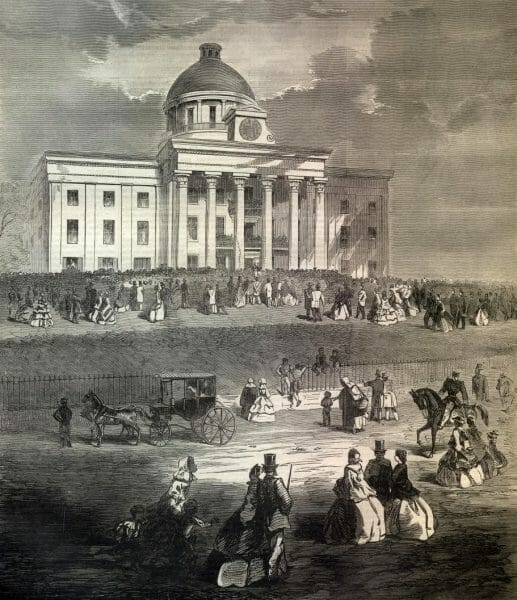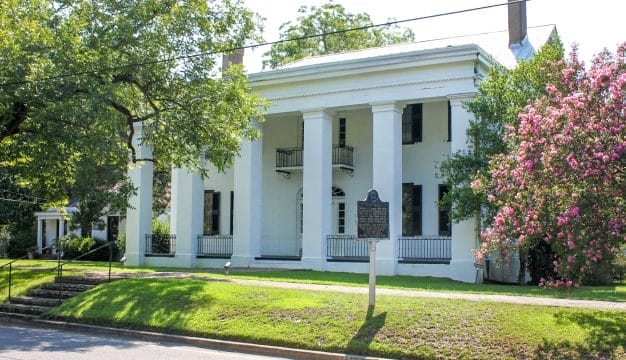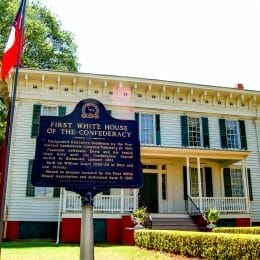First White House of the Confederacy
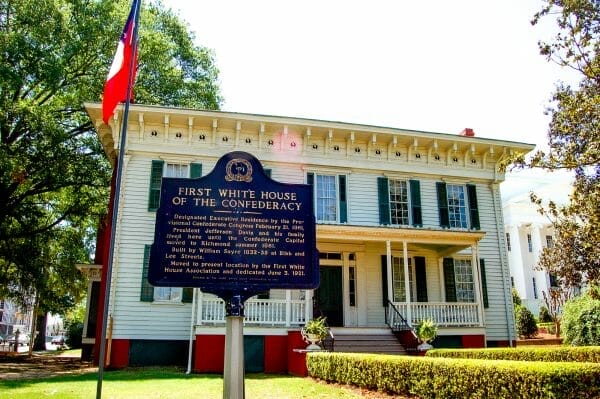 First White House of the Confederacy
The First White House of the Confederacy, located in Montgomery, was the executive residence of Confederate president Jefferson Davis and his family from February to May 1861, when Montgomery was the capital of the Confederacy. The house was moved to its present location, at 644 Washington Avenue, from the southwest corner of Bibb and Lee Streets in 1921 to prevent damage as the neighborhood underwent renovation. Davis resided in the house for only three months, and thus much of the house’s story concerns the preservation efforts of the White House Association of Alabama.
First White House of the Confederacy
The First White House of the Confederacy, located in Montgomery, was the executive residence of Confederate president Jefferson Davis and his family from February to May 1861, when Montgomery was the capital of the Confederacy. The house was moved to its present location, at 644 Washington Avenue, from the southwest corner of Bibb and Lee Streets in 1921 to prevent damage as the neighborhood underwent renovation. Davis resided in the house for only three months, and thus much of the house’s story concerns the preservation efforts of the White House Association of Alabama.
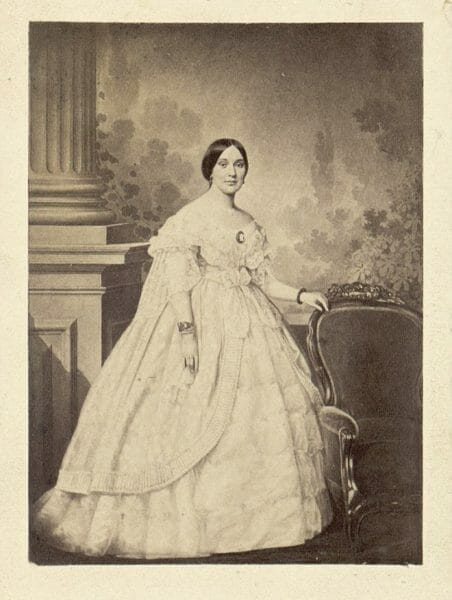 Varina Howell Davis
The Federal-style house was built between 1832 and 1835 by William Sayre, a lawyer and ancestor of Zelda Sayre Fitzgerald. In the 1850s, owner Col. Edmond Harrison remodeled the home in the Italianate fashion that was then sweeping Alabama; it was he who leased the home to the Confederate government. After Alabama seceded from the Union on January 11, 1861, representatives from the other seceding states met in Montgomery to form a new government. The delegates to the constitutional convention named Jefferson Davis provisional president on February 9, and he was inaugurated on the portico of the Capitol on February 18, 1861. On February 21, the Provisional Congress authorized the lease of an executive mansion, furnished and staffed, for $5,000 a year. Davis’s wife, Varina Anne Howell, approved the house, and the couple entertained many important people at the house.
Varina Howell Davis
The Federal-style house was built between 1832 and 1835 by William Sayre, a lawyer and ancestor of Zelda Sayre Fitzgerald. In the 1850s, owner Col. Edmond Harrison remodeled the home in the Italianate fashion that was then sweeping Alabama; it was he who leased the home to the Confederate government. After Alabama seceded from the Union on January 11, 1861, representatives from the other seceding states met in Montgomery to form a new government. The delegates to the constitutional convention named Jefferson Davis provisional president on February 9, and he was inaugurated on the portico of the Capitol on February 18, 1861. On February 21, the Provisional Congress authorized the lease of an executive mansion, furnished and staffed, for $5,000 a year. Davis’s wife, Varina Anne Howell, approved the house, and the couple entertained many important people at the house.
After Fort Sumter was fired upon on April 12 and Virginia seceded on April 17, the Confederate government moved to Richmond, Virginia, on May 20 and remained there until the end of the Civil War. Contents of the Montgomery house were auctioned off. Several prominent families owned the house, but in the late 1890s, as efforts were discussed to preserve the house, the owner refused to sell it because the land on which it sat was growing ever more valuable as the neighborhood gradually turned into a business district.
The Alabama Division of the United Daughters of the Confederacy (UDC), organized in 1897, assumed the preservation of the “Jeff Davis House” as its project. At century’s end, suggestions were made about using the house as a memorial library in honor of Winnie Davis, the daughter of Jefferson and Varina, a memorial hall for Confederate relics, or a home for Confederate veterans. Although the Alabama UDC raised some $1,000 for moving the house, members became entangled in personal differences and abandoned the project.
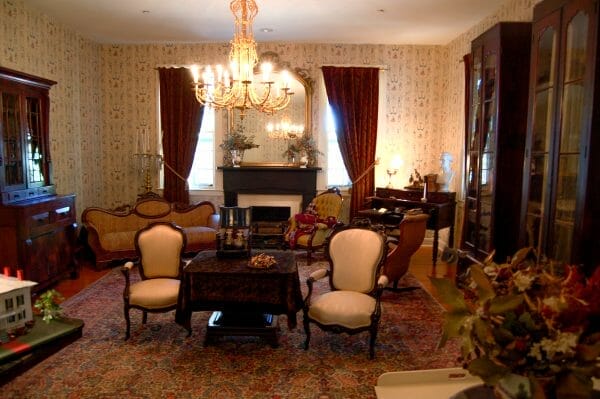 Jefferson Davis’s Study
A new group, the White House Association (WHA) of Alabama, was founded on July 1, 1900, for the purpose of saving and preserving the first White House of the Confederacy but struggled for nearly 20 years as the residence became a boarding house and fell into disrepair. When the owner at the time, listed as Mrs. R. L. Render, died in LaGrange, Georgia, in 1918, her heirs took possession of the property. Render’s husband was sympathetic to the WHA cause and promised to sell the house to the association for $800. After his death however, the heirs first attempted to sell the house for at least $2,000, which was the estimated value of the timber, but consented to the previously agreed upon sum, with the condition that price was for the house and not the property.
Jefferson Davis’s Study
A new group, the White House Association (WHA) of Alabama, was founded on July 1, 1900, for the purpose of saving and preserving the first White House of the Confederacy but struggled for nearly 20 years as the residence became a boarding house and fell into disrepair. When the owner at the time, listed as Mrs. R. L. Render, died in LaGrange, Georgia, in 1918, her heirs took possession of the property. Render’s husband was sympathetic to the WHA cause and promised to sell the house to the association for $800. After his death however, the heirs first attempted to sell the house for at least $2,000, which was the estimated value of the timber, but consented to the previously agreed upon sum, with the condition that price was for the house and not the property.
As earth-moving equipment began excavating the adjoining property, there were fears that the house would be razed, and public protest arose to save the historic building. The hue and cry reached the ears of Gov. Thomas E. Kilby, and he approved legislation authorizing $25,000 and a commission to find and purchase land on which to place the house and oversee its removal and renovation.
Although the WHA had found funding and an ally in the governor, the complicated task of actually moving the house to its new location had to be addressed. The structure was first photographed from all four sides and detailed plans were made of the interior. The building was subsequently divided into three sections and each board was marked and disassembled. It was then moved to Washington Avenue and carefully reassembled. The WHA presented the house, fully restored, to the state and people of Alabama in elaborate ceremonies, replete with a parade, banquet, and bands on June 3, 1921, the 113th anniversary of Jefferson Davis’s birthday.
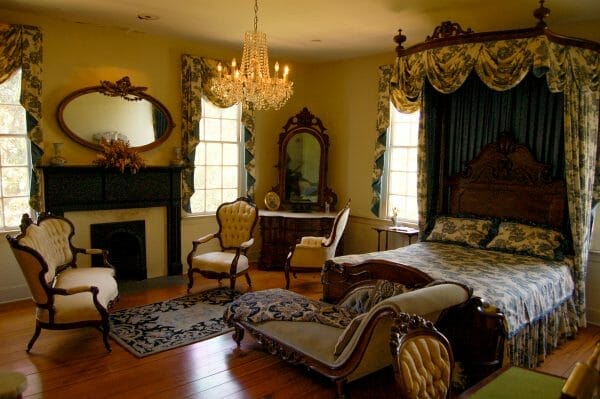 Guest Room
The house is decorated with many Davis possessions donated by Varina and stored by the WHA, including the family bible and furniture, as well as portraits, Civil War artifacts, and accoutrements contemporary to the era. The Jefferson Davis bedroom contains the president’s bed, and furniture is placed according to a diagram supplied by Varina. The furniture in her bedroom, although not original, includes a bed slept on by the Marquis de Lafayette at an inn in Worthington, Massachusetts, during his travels through the United States. The study is furnished with a table upon which the president wrote The Rise and Fall of the Confederate Government, a mahogany desk he used at the house in Richmond, and his last residence, Beauvoir, in Biloxi, Mississippi, and bookcases owned by Alabama governor Thomas H. Watts (1863-1865). The first of two parlors display chairs owned by William Rufus King, Alabama senator and vice president of the United States, and the dining room exhibits a tea set and silver service used by the Davis family. Other rooms are decorated with furniture from the Majestic Hotel in New York City, where Varina died, including her deathbed, the family’s baby bed, and artifacts related to generals Robert E. Lee and Thomas Jonathan “Stonewall” Jackson.
Guest Room
The house is decorated with many Davis possessions donated by Varina and stored by the WHA, including the family bible and furniture, as well as portraits, Civil War artifacts, and accoutrements contemporary to the era. The Jefferson Davis bedroom contains the president’s bed, and furniture is placed according to a diagram supplied by Varina. The furniture in her bedroom, although not original, includes a bed slept on by the Marquis de Lafayette at an inn in Worthington, Massachusetts, during his travels through the United States. The study is furnished with a table upon which the president wrote The Rise and Fall of the Confederate Government, a mahogany desk he used at the house in Richmond, and his last residence, Beauvoir, in Biloxi, Mississippi, and bookcases owned by Alabama governor Thomas H. Watts (1863-1865). The first of two parlors display chairs owned by William Rufus King, Alabama senator and vice president of the United States, and the dining room exhibits a tea set and silver service used by the Davis family. Other rooms are decorated with furniture from the Majestic Hotel in New York City, where Varina died, including her deathbed, the family’s baby bed, and artifacts related to generals Robert E. Lee and Thomas Jonathan “Stonewall” Jackson.
As an educational institution, the house focuses on the formation of the Confederate States of America, Jefferson Davis and his family, and its preservation. The state maintains the house and grounds, whereas the WHA owns and maintains the objects inside and manages the house. It is staffed by state merit-system employees.
Further Reading
- Napier, Cameron Freeman. The First White House of the Confederacy. Montgomery: First White House Association, 1993.
- ———. The Struggle to Preserve the First White House of the Confederacy. Tuscaloosa: University of Alabama Press, 1983.
